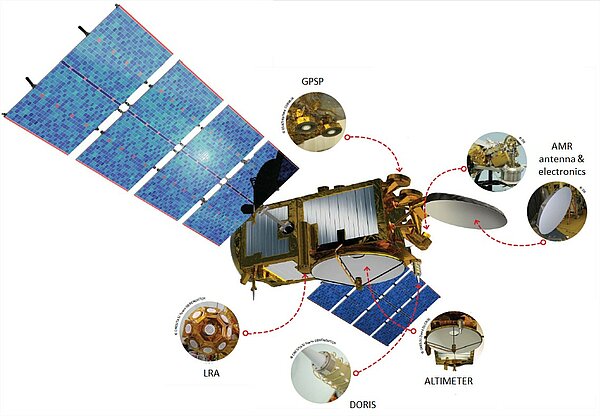Instruments on Jason-3
On the Proteus platform, Jason-3 is carrying a payload of several instruments : the Poseidon-3B altimeter, the mission's main instrument, which measures range; the AMR radiometer, which measures perturbations due to atmospheric water vapor; three location systems (Doris, LRA and GPSP) and two experimental instruments (Carmen-3, LPT).
The Poseidon-3B altimeter
The Poseidon-3B, supplied by Cnes, is the mission's main instrument, derived from the altimeters on Jason-1 and then Jason-2. It allows to measure the range (the distance from the satellite to the Earth's surface), wave height and wind speed.It This new altimeter implements a mixed mode allowing on-board automatic transitions between the Diode/DEM mode and the acquisition/tracking mode with respect to the satellite position. Indeed, Jason-2 uses the two altimeter modes, the "autonomous tracking" and the Diode/DEM modes, to improve measurements over coastal areas, inland waters and ice. But these modes have the disadvantage to be exclusive.
The Advanced Microwave Radiometer (AMR)
Developed by Nasa, it measures radiation from the Earth's surface. Each frequency is combined to determine atmospheric water vapor and liquid water content. Once the water content is known, the correction to be applied for radar signal path delays is determined. It will performed thorough lesson learned review from Jason-2 experience with: account for parts obsolescence, improve the instrument thermal control and stability, small design updates to retire residual implementation risks on Jason-2. Unlike the radiometers of its predecessors, the calibration of the Jason-3 AMR will be completed with pitch manoeuvres in order to perform cold-space measurements at regular intervals (every 30 to 60 days).
Locations systems
The location systems onboard Jason-3 complement each other to measure the final satellite's position on orbit to within 1-2 centimeters on the radial component. A significant change is made on the real-time orbit where the rms on the radial component should be 5 cm, computed from the real-time Doris-Diode onboard ephemeris (the requirements are about 10 cm for Jason-2).
The GPS receiver (GPSP)
The GPSP uses the Global Positioning System (GPS) to determine the satellite's position by triangulation, in the same way that GPS fixes are obtained on Earth. At least three GPS satellites determine the mobile's exact position at a given instant. Positional data are then integrated into an orbit determination model to track the satellite's trajectory continuously.
Supplied by Nasa, it will be a different receiver but with same basic (blackjack) design as on Jason-1 and 2. No changes to data processing or products with expect same or better performance as on Jason-2.
Doris (Doppler location)
The Doris system uses a ground network of 60 orbitography beacons around the globe, which send signals at two frequencies to a receiver on the satellite. The relative motion of the satellite generates a shift in the signal's frequency (called the Doppler shift) that is measured to derive the satellite's velocity. These data are then assimilated in orbit determination models to keep permanent track of the satellite's precise position (to within three centimeters) on its orbit.
This instrument is supplied by Cnes with a new generation (DGXXS) taking into account lessons learned from Jason-2. Improvement in modeling solar panels position will be made. Current model improvements will be integrated: albedo and infra-red pressure, new ITRF, pole prediction, Hill along-track empirical acceleration, on-board USO frequency prediction, ... allowing a more and more accurate Diode navigation tool.
LRA (laser tracking)
The LRA instrument, provided by NASA, is an array of mirrors that provides a target for laser tracking measurements from the ground. By analyzing the round-trip time of the laser beam, the satellite's orbit location can be determined.
Passengers instruments
Carmen-3 is a dosimeter developed by CNES that is used to improve knowledge of particularly aggressive radiation in Jason’s orbit (Doris, assessment of electronic risks).
The LPT is another dosimeter and is provided by JAXA.
































